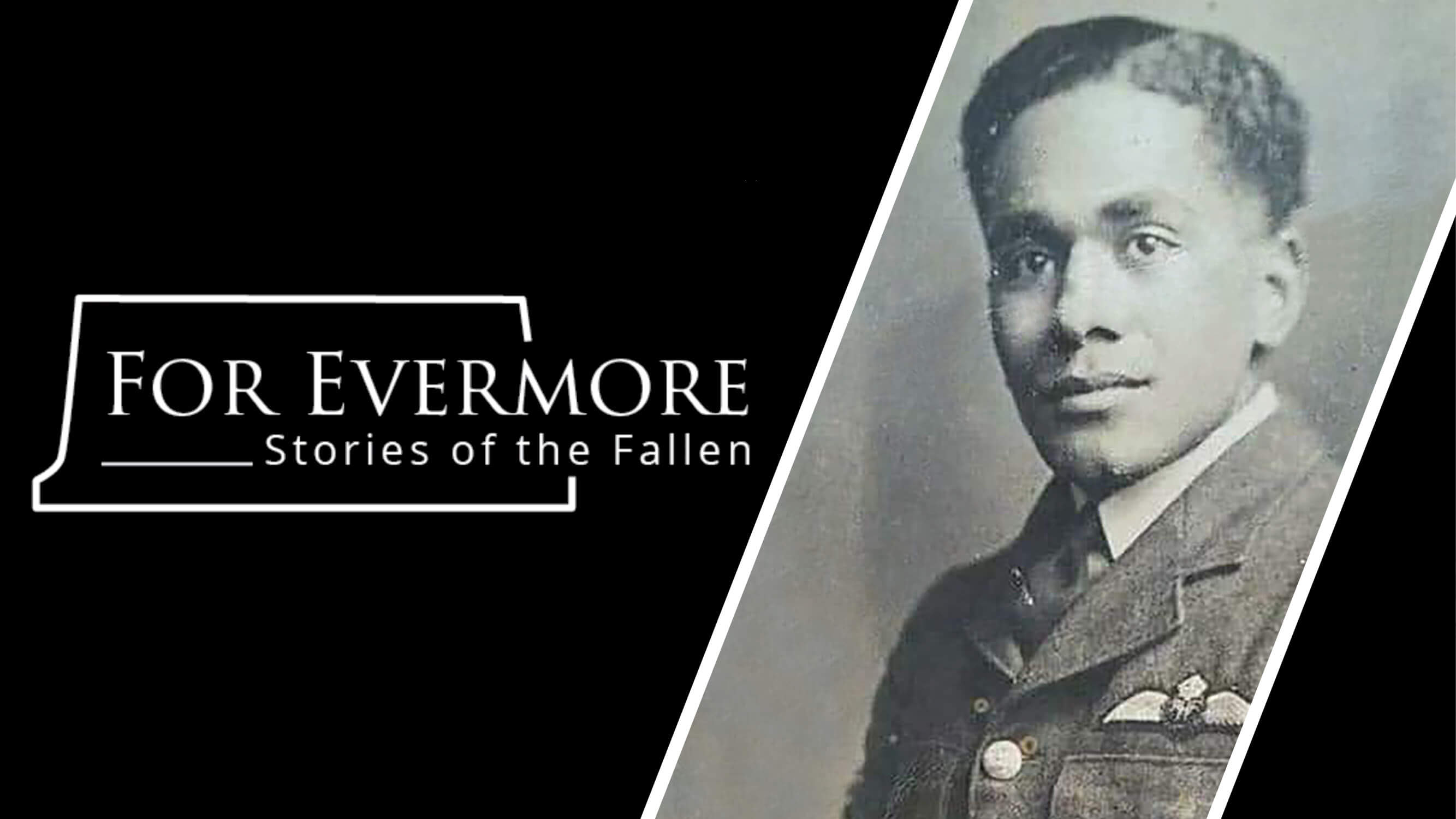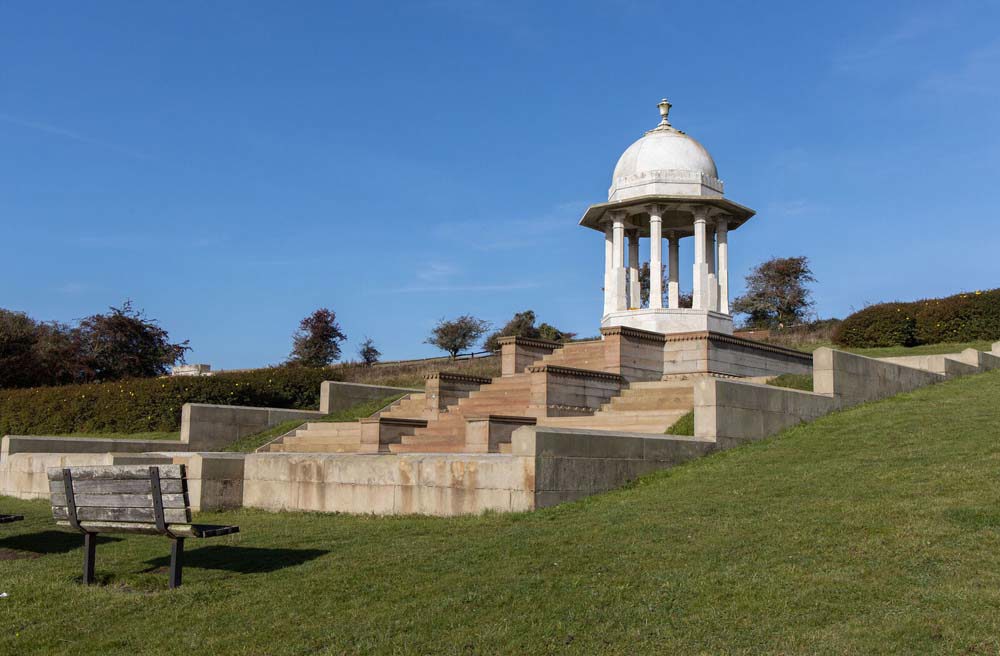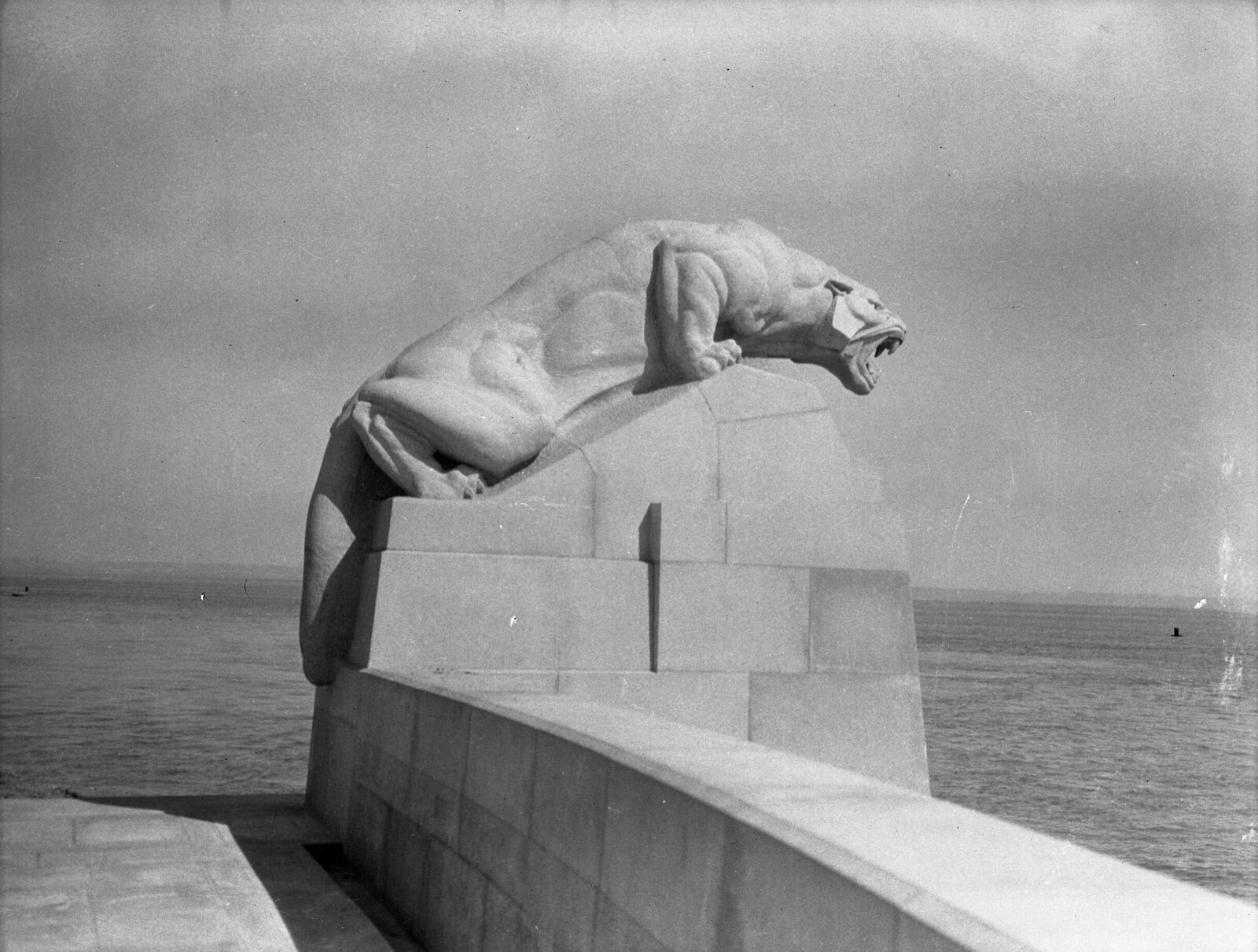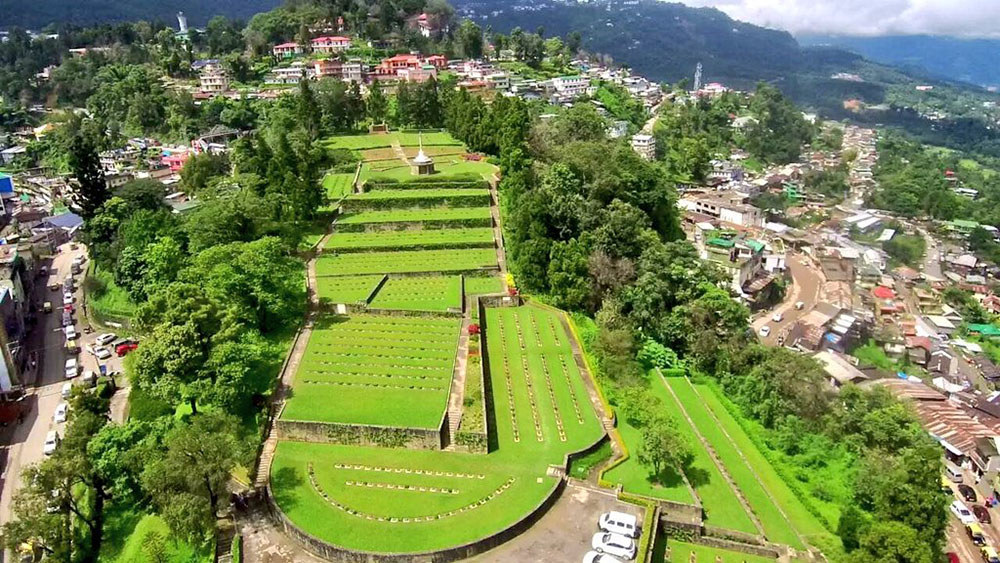21 July 2025
Courage, sacrifice, honour: Cemeteries & Memorials commemorating Indian Army personnel
Over 160,000 Indian casualties of the World Wars lie in Commonwealth War Graves’ care. Discover their resting places and stories today.
Indian Army cemeteries & memorials
The Indian Army in the World Wars
The Indian Army & The First World War

Image: Lewis gun emplacement in a trench held by the 3/3rd Ghurkha Rifles, 75th Division (© IWM (Q 12937B))
Within days of Great Britain’s declaration of war upon Imperial Germany, Indian Army units were mobilised and heading for the Western Front.
The first members of the Indian Expeditionary Force landed in France in September 1914. By October, they were in action at the bloody fighting for Messines Ridge.
But while the Western Front and battles like the clash at Neuve-Chapelle have entered Indian Army folklore, France and Flanders are not the only chapters in its Great War story.
Between 1914 and 1918, the Indian Army fought in Europe, East Africa, the Eastern Mediterranean, and the Middle East.
How many Indians were killed in the First World War?

Image: During a march past of Indian troops, a woman pins flowers on to the tunic of one of the soldiers (© IWM (Q 70214)
The Indian Army swelled in size during wartime. What had begun the war as a 150,000-strong army grew to an organisation of over a million men and women in uniform.
The Commonwealth War Graves Commission commemorates by name approximately 74,000 officers and enlisted men of the Indian Army who died in the First World War.
Of these, some 8,000 are buried in CWGC war cemeteries, each with their own war grave. Otherwise, the remaining 65,000 are commemorated by name on a CWGC war memorial.
Do Indian Army soldiers have war graves?
The Indian Army was, and still is, a major military force, made up of servicemen and women from a variety of religious faiths and cultural backgrounds.
As such, not every Indian Army soldier is commemorated by a CWGC war grave or headstone. Many are commemorated by name on different war memorials worldwide.
Following their beliefs, a large number of Indian Army soldiers were cremated upon death.
After the First World War, the soldiers who were originally commemorated by CWGC memorials to the missing. However, this wasn’t strictly accurate, as their bodies had been recovered but had been simply cremated rather than buried.
The Commonwealth War Graves Commission subsequently introduced cremation memorials after the Second World War to appropriately commemorate cremated Indian Army personnel.
Indian Army First World War Cemeteries & Memorials
Neuve-Chappelle Memorial
Over 140,000 Indian soldiers, cavalrymen and non-combatant labourers served on the Western Front during the First World War.
The first formation, the Indian Corps, comprising the 3rd (Lahore) and 7th (Meerut) divisions, arrived in September, was in combat by October, and was spearheading attacks by March 1915.
At the Battle of Neuve-Chapelle, fought between 10-13 March 1915, the Indian Corps fought its first major battle of the First World War as a single unit.
The Indians made up half the attacking force at Neuve-Chapelle. Despite taking horrendous casualties, they pushed on and take a section of the German front line. Ultimately, the village of Neueve-Chappelle was captured.
The Neuve-Chapelle Memorial commemorates over 4,700 Indian soldiers and labourers who lost their lives on the Western Front during the First World War and have no known graves. Its location was chosen for the special connection Neuve-Chapelle holds for the Indian Army in the Great War.
Designed by Sir Herbert Baker, the memorial features several architectural flourishes that connect it with the architecture and traditions of India.
This WW1 memorial takes the form of a sanctuary enclosed within a circular wall after the manner of the enclosing railings of early Indian shrines. The column in the foreground of the enclosure stands almost 15 feet high and was inspired by the famous inscribed columns erected by Emperor Ashoka throughout India in the 3rd century BC.
On the lower part of the column, the words ‘God is One, He is the Victory’ are inscribed in English, with similar texts in Arabic, Hindi, and Gurmukhi.
Patcham Down Memorial
By October 1914, Brighton on the south coast of England had become the centre for Indian Army medical care in the UK.
The Indian architecture-themed Royal Pavilion and Kitchener Indian General Hospital, a converted workhouse, were major treatment facilities for Indian Army soldiers, specially designed to accommodate the Muslims, Sikhs, Hindus and other cultures represented among the fighting forces of India.
Around 4,300 Indian patients passed through the Pavilion Estate medical hub between October 1914 and September 1916 alone. The majority returned to their units on the frontline, but others sadly died while seeking treatment.
A spot overlooking Brighton and Hove and the sea at Patcham Down was chosen as the cremation site for those wishing to be burned in accordance with their faith.
Just over 50 men were cremated at Patcham Down during the war. Initially, they were commemorated on memorials like Neuve-Chappelle, but it was decided in 2009 to give them a permanent cremation memorial, which was unveiled in 2010.
The Patcham Down Indian Forces Cremation Memorial bears an inscription written in Hindi, Punjabi and English that reads:
"IN HONOUR OF THESE SOLDIERS OF THE INDIAN ARMY WHOSE MORTAL REMAINS WERE COMMITTED TO FIRE"
Heliopolis (Port Tewfik) Memorial
More than 5,000 Indian Army personnel of the First World War are buried or commemorated in Egypt. Over 3,000 are commemorated at a single site: the Heliopolis (Port Tewfik) Memorial.
For more than half a century, the memorial’s twin crouching tiger guardians stood fiercely over the mouth of the mighty Imperial artery of the Suez Canal, coiled, ready to strike, calling on passersby to remember the more than 3,000 Indian soldiers of the Great War who died in Egypt and Palestine.
Sadly, the original memorial was damaged beyond repair during the 1967 Arab-Israeli War. Its tigers were no longer so fierce.
In the 1970s, after attempts to repair the memorial proved fruitless, the decision was made to rebuild the Heliopolis (Port Tewfik) Memorial within the grounds of Heliopolis War Cemetery in Cairo, 75 miles away from its original location.
The Commission also took the time to restore a historic inequality in commemoration when rebuilding the memorial.
When originally unveiled in 1926, the memorial commemorated no service personnel by name. Only units and regiments were mentioned as Colonial and Army records were unsatisfactory to Commission requirements.
With the correct war records found, and names added to the registry, the Commission was able to properly commemorate each of the 3,700 officers and enlisted men by name.
Three bronze tiger plaques were added to the memorial once reconstructed, still snarling, still defiant, still in commemoration of the men of the Indian Army who never left Egypt and Palestine in the Great War.
Indian Army Stories of the First World War
Rifleman Gobar Singh Negi VC
Gobar Singh Negi was born in the Himalayan mountain village of Manjaur on 21 April 1895.
In October 1913, Gabar enlisted in the British Indian Army, joining the 2nd Battalion, 39th Garwhal Rifles, a regiment primarily comprised of soldiers, like Gabar, Uttarakhand.
The 39th Garwhal Rifles was selected to join Indian Expeditionary Force A, assigned to the Western Front in France. The unit was in action by October 1914 when, as part of the 7th (Meerut) Division, it fought at the First Battle of Ypres.
The 7th Division was later moved to the Pas-de-Calais sector where it stayed until going into reserve at the end of 1914.
Gabar and the 7th Division fought in the Battle of Neuve Chapelle, assaulting the German lines around the village.
The 2nd Battalion was attacking to the southwest of Neuve Chappelle on 10 March. The artillery barrage preceding the infantry assault had not been effective, and the German trenches were still strongly defended.
Bombing parties were arranged to take the trench, one of which included Gabar. The party commander was killed, so Gabar took control of the situation, continuing to lead from the front until the trench was taken.
Gabar was killed in the attack. For his actions, he was posthumously awarded the Victoria Cross. Gabar’s medal citation reads:
“For most conspicuous bravery on 10th March, 1915, at Neuve Chapelle. During our attack on the German position he was one of a bayonet party with bombs who entered their main trench, and was the first man to go round each traverse, driving back the enemy until they were eventually forced to surrender. He was killed during this engagement.”
As Gabar has no known grave he is commemorated on the Neuve-Chapelle Memorial.
Major Pandit Piarayal Atal
 Image: Major Pandit Piarayal Atal (© IWM HU 123768)
Image: Major Pandit Piarayal Atal (© IWM HU 123768)
Born in 1872, Pandit was the son of Kishanlal Atal, the Private Secretary to the Maharaja of Jodhpore, and the grandson of the former Prime Minister of Jaipur State.
He grew up in Jaipur but attended medical school in Lahore. After graduating he travelled to England and continued to study medicine.
Pandit joined the British Army in 1899, and before the outbreak of the First World War he served at home in India and in China, reaching the rank of Major.
During the First World War he served as a medical officer with the 129th Duke of Connaught's Own Baluchis.
He was in the thick of the action several times and was mentioned in dispatches for attending the wounded while under fire.
This remarkable 43-year-old veteran soldier died on 23 November 1914, when the medical post he was working in was hit by enemy shell fire.He left behind a wife and five children.
He is commemorated by name on CWGC’s Neuve-Chapelle Memorial in France.
The Indian Army in the Second World War

Image: Indian army tanks and transport lorries crossing the desert of Northeast Africa (© IWM (E 3721E))
India was obliged to join the British Empire in a global conflict once more with the outbreak of the Second World War in September 1939.
The expansionist actions of Imperial Japan brought the war to India’s doorstep. Indian Army troops were instrumental in the victories at Kohima and Imphal, stopping the Japanese Army from entering India.
Indian units were involved in actions throughout the war in the Far East, fighting in defence of Singapore and Malaysia, as well as proving vital in the recapture of Burma (present-day Myanmar),
Much like their Great War counterparts, the Indian Army was active in Africa, the Middle East, and the Mediterranean in the Second World War.
Battle honours include the wars in the deserts of Africa against Rommel’s Afrika Korps, including El Alamein, and the difficult fighting in Italy and the Battle of Monte Cassino.
How many Indians were killed in the Second World War?
During the Second World War, the Indian Army became the largest all-volunteer in history. At its peak, 2.5 million people served in the Indian Army’s multi-cultural ranks.
The Commonwealth War Graves Commission commemorates over 87,700 Indian armed forces personnel who lost their lives in the Second World War.
This includes the Indian Army, but those who served and died in the navy, air force, and merchant fleet during wartime.
Indian Army Second World War Cemeteries & Memorials
Kingussie Cemetery
An unusual place to start but Kingussie Cemetery, in the small town of Kingussie, set amidst the stunning Cairngorms mountains, holds a small handful of Indian Army war graves of the Second World War.
In 1940, Force K6 landed in the UK: the only Indian soldiers of the war to be posted to Britain. Force K6, later renamed the Indian Contingent, was a mule-transport unit, that specialised in using mules to ferry supplies to and from the frontline.
The unit had been involved in the evacuation at Dunkirk following the fall of France and subsequently spent most of its time in the UK.
In 1942, Force K6 was sent to the Cairngorms in the beautifully rugged Scottish Highlands for mountain training. Sadly, due to accidents or illness, 14 K6 troopers died while in Scotland and today 9 are buried in Kingussie Cemetery.
A cremation memorial, dedicated to all 14 members of the unit, mostly Muslim and Hindus, who died in Scotland was unveiled in September 2022.
Kohima War Cemetery
Kohima, together with the Battle of Imphal, has a special place in British military history. For some, the victory here is the greatest ever pulled off by troops fighting under British command. In no small part, the triumph at Kohima and Imphal belongs to the Indian Army.
It was here, in early 1944, that the British and Indian Army under the command of General Bill Slim, stopped dead the Japanese advance into India, putting Japanese armies into retreat. From here, the Allies began to turn the tide in Burma, eventually leading to victory in the East.
A battle as iconic as Kohima deserves a cemetery to match - and Kohima War Cemetery is probably Commonwealth War Graves’ most iconic cemetery in Asia.
The first burials were made here during the fighting in 1944. Soon, it was decided a permanent cemetery should be built here, dedicated to the men who fought and fell at Kohima.
Isolated graves were soon brought in from the surrounding countryside. Plots for different religions were established too.
In 1948, the Commission was appointed to care for Kohima War Cemetery. In turn, the Commission assigned Colin St. Claire Oakes to redesign the site.
Oakes incorporated the site’s unique characteristics into his multi-tiered, terraced design, including the outline of the tennis court where Indian and British soldiers clashed in hand-to-hand combat with their Japanese opponents.
Today, almost 1,300 Commonwealth servicemen are buried here. More than 900 Hindu and Sikh soldiers who were cremated in accordance with their faith are commemorated on the Kohima Cremation Memorial within the cemetery.
Sangro River Cremation Memorial
More than 5,500 Indian servicemen are commemorated by Commonwealth War Graves Commission cemeteries and memorials in Italy.
The Indian Army fought in some of the toughest campaigns of the Italian theatre, including the crossing of the Sangro River, the clashes at Monte Cassino, and the push north towards the River Po in 1945.
There are three cremation memorials dedicated to officers and enlisted men of the Indian Army who were killed in Italy and cremated in accordance with their faith:
Of these, the Sangro River Cremation Memorial is the largest. It commemorates just under 520 Indian Army personnel.
Indian Army Stories of World War Two
Naik Yashwant Ghatge VC
 Image: Naik Yashwant Ghatge VC (public domain)
Image: Naik Yashwant Ghatge VC (public domain)
Yashwant Ghatge was born in the small town of Mangaon, India, on 16 November 1921.
In 1944, Yashwant was serving as a Naik, equivalent to a Corporal in the British Army, with the 5th Light Mahratta Light Infantry. He had previously served as a Sepoy, earning a Mention in Despatches for his conduct in 1941.
On 10 July 1944, the 5th Light Mahratta Infantry was fighting in Italy, advancing up the Upper Tiber Valley. Fighting in Italy was incredibly tough, and the Indian Army sustained many casualties in the Italian theatre.
While on the advance, Yashwant’s rifle section came under heavy machine-gun fire at extremely close range. In a few deadly salvos, Yashwant’s unit was wiped out except for the young Naik.
Despite the horrendous damage to his squad, Yashwant leapt into action. He threw a grenade into the machine-gun nest, taking out the gunner, and shooting another of the gun crew.
While pausing the reload, Yashwant was struck by a sniper’s bullet and mortally wounded. One account of the action suggests Yashwant was also clubbed by German soldiers.
For his courage under fire and self-sacrifice, Yashwant was posthumously awarded the Victoria Cross: Britain’s highest military honour.
Yashwant’s medal citation, as published in the London Gazette, reads as follows:
“In Italy, on 10th July 1944, a company of the 5th Mahratta Light Infantry attacked a position strongly defended by the enemy. A rifle section commanded by Naik Yashwant Ghatge came under heavy machine-gun fire, which killed or wounded all the section except the commander.
“Without hesitation, Naik Yashwant Ghatge rushed the machine-gun post. He threw a grenade, shot one of the crew, and then, grasping his gun by the barrel, killed the remaining two men.
“Finally he was shot by enemy snipers and died in the post which he had captured single-handed. The courage, determination, and devotion to duty of this Indian N.C.O. in a situation where he knew the odds against him gave little hope of survival were outstanding.”
Yashwant has no known grave and is commemorated on the Cassino Memorial.
Sepoy Wellington Massar DCM
Sepoy Wellington Massar was born in the Khasi Hills in Meghalaya, India, in 1925. He was the son of Padma Saikia and Rodamai Massar.
Massar grew up to serve with the first battalion of the Assam Regiment and was recognised for his role in the Battle of Jesami on 28 March 1944 - the first battle with the Japanese to be fought on Indian soil.
He held his post despite repeated attacks and when the withdrawal was finally ordered, he was the last man to leave the sector.
Massar also saw action at the Battle of Kohima on 15 April 1944. He set up his machine gun on the top of a billiard table in a bombed clubhouse and provided continuous covering fire for his comrades. Despite being wounded in the leg he refused to be evacuated and had his wounds dressed on the spot.
Massar survived the action but later died of gangrene on 18 May 1944, aged 19. He was posthumously awarded the Indian Distinguished Service Medal for his actions at Jessami and Kohima.
He is commemorated in CWGC Imphal War Cemetery, India at plot 7.G.21.

Introducing For Evermore: Stories of the Fallen - the exciting new way to read and share stories of the Commonwealth's war dead. Got a story to share? Upload it and preserve their memory for generations to come.
Share and read stories


















